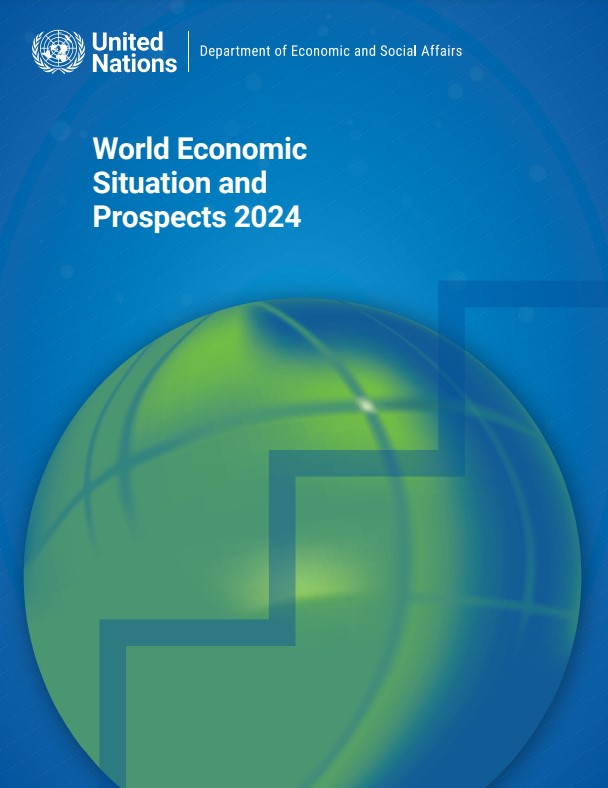
□ 한국경제는 2023년 1%대 성장세에서 벗어나 세계 경제 성장률과 같은 2.4%의 성장률을 올해 나타낼 것으로 예상함. 보고서는 한국경제에 대해 ”민간소비의 둔화는 고물가 지속으로 실질임금이 하락한 것을 반영한다”면서도 ”긴축적 통화정책과 금융비용 상승에도 불구하고 2023년 민간투자가 완만하게 회복되면서 2024년 성장률 전망치를 높이는 데 기여했다”고 평가함
□ 권역별 올해 성장률 전망치를 보면 미국이 1.4%로 직전 보고서 대비 0.4%포인트 상향 조정됐고, 일본(1.2%)과 중국(4.7%)도 직전 보고서 대비 각각 0.2%포인트 상향됨. 반면, 유럽연합은 1.2%로 종전 대비 0.3%포인트 하향 조정됐고, 영국도 0.4%로 종전 대비 0.7%포인트 하향 조정됨. 신흥국 성장률 전망치도 종전 대비 0.2%포인트 낮춘 4.0%로 제시함
[출처] 유엔, 올해 세계 경제 성장률 전망 2.4%로 하향…한국 2.4% 예상 (2024.01.05.) / 연합뉴스
목차
Foreword III
Explanatory notes IV
Acknowledgements V
Sustainable Development Goals VI
Executive Summary VII
Chapter I. Global Economic Outlook 5
Global economic environment and growth prospects 5
Resilience in growth masks underlying risks and vulnerabilities 5
Growth is projected to moderate in 2024 8
A protracted period of low growth is looming 10
Inflation, food insecurity and poverty 11
Inflation declined in most countries but remains a key policy challenge 11
Higher food prices exacerbate food insecurity 14
Elevated inflation hampers poverty reduction 14
Labour market trends and challenges 15
Developed country labour markets remained strong 15
Labour markets in developing countries exhibit mixed trends 18
Gender gaps and youth unemployment remain key policy challenges 18
Prospects for global investment and trade 19
Global investment is likely to remain subdued 19
Massive gaps in renewable energy investment remain 21
Global trade is facing multiple headwinds 22
International finance and debt challenges 27
Large shortfalls remain in financing sustainable development 27
Official development assistance for the least developed countries is declining 28
Debt burdens impede progress towards the Sustainable Development Goals 29
Macroeconomic policy challenges 31
Monetary policy 31
Fiscal policy 33
Industrial policy 36
International cooperation 39
Chapter II. Global Monetary Tightening: Risks and Challenges 47
Introduction 47
The global financial crisis and quantitative easing 48
An unconventional response to the global financial crisis 48
The effects of quantitative easing on the economy 51
Quantitative easing prevented a financial catastrophe but also had longer-term consequences 53
Large spillover effects of quantitative easing on developing economies 57
Transmission channels and impacts 57
Developing country central banks also turned to quantitative easing during the pandemic 63
Quantitative easing benefited the wealthy in developing economies as well 64
From quantitative easing to quantitative tightening: challenges for developed economies 65
A difficult exit from quantitative easing 65
The new round of quantitative tightening amid high inflation 65
Quantitative tightening poses significant challenges to developing economies 72
Rising financial risks and fiscal challenges for developing economies 72
Weakening export growth for developing economies 73
Squeezing the macroeconomic policy space of developing economies 75
Developing country policy options for navigating challenging times 76
Domestic policy options 76
International cooperation 82
CHAPTER III. Regional Developments and Outlook 87
Developed economies 87
Northern America 87
European Union and other economies in Europe 89
Developed economies in Asia 94
Economies in transition 97
Commonwealth of Independent States and Georgia 97
South-Eastern Europe 102
Developing economies 105
Africa 105
East Asia 111
South Asia 117
Western Asia 121
Latin America and the Caribbean 127
해시태그
관련자료
AI 100자 요약·번역서비스
인공지능이 자동으로 요약·번역한 내용입니다.



